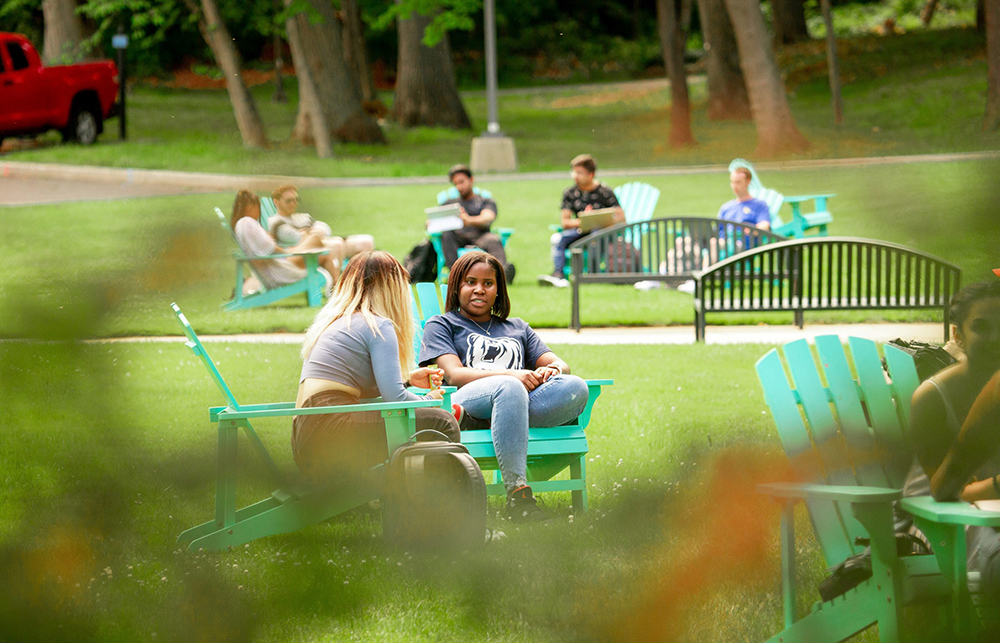
隨著新冠新增病例激增現(xiàn)象的消退,,越來越多的公司都在要求雇員回歸辦公室,或至少有這樣的打算,。然而對眾多員工來說,,這些辦公室將再也不是2020年3月時的模樣。
包括科技領(lǐng)袖Salesforce和Spotify在內(nèi)的無數(shù)公司,,對辦公室進(jìn)行了大刀闊斧的調(diào)整,,例如家具和桌椅布局等,以更好地推動員工協(xié)作,。然而,,這只不過是美國企業(yè)使用設(shè)計這個工具來最大程度提升員工滿意度和生產(chǎn)力的最新案例。多年來,,一些頗具前瞻性的美國企業(yè)摒棄了傳統(tǒng)的辦公室準(zhǔn)則,使用能夠強化人際關(guān)系,、提升職場生活品質(zhì)的貼心空間來替代傳統(tǒng)的小隔間和枯燥的會議室,。
另一方面,說到針對其教職員工和學(xué)生的空間設(shè)計,,學(xué)院和大學(xué)在歷史上便一直落后于美國企業(yè),。這些高等教育機構(gòu)在設(shè)計空間時關(guān)注的并非是學(xué)生體驗,而是捐贈者和管理者,。它們的設(shè)計講究的是地位和權(quán)威,,而不是舒適的環(huán)境、功能和公平的獲取機會,。
在新冠疫情之前,,學(xué)生除了適應(yīng)校園環(huán)境之外別無選擇。然而疫情改變了這一切,,因為它永久地改變了學(xué)校,、企業(yè)、醫(yī)院以及基本上社會其他各個角落對和諧物理空間的定義。
如今,,大學(xué)管理者迎來了罕有的突破性機會,,來打造能夠讓學(xué)生真正感到舒適的校園內(nèi)部環(huán)境。高等教育機構(gòu)應(yīng)該詢問學(xué)生對校園的需求,,并確保其首要任務(wù)是改善公平性和接觸機會,。
不妨看看企業(yè)布局設(shè)計所帶來的價值。辦公用品公司范羅士(Fellowes)《職場健康度趨勢報告》顯示,,近90%的受調(diào)雇員希望雇主提供更加健康的職場空間,,從坐站兩用辦公桌和人體工學(xué)座椅一直到康體室。
其中很多雇主都傾聽了雇員的意見,,在辦公室設(shè)計規(guī)劃時以員工為中心,。谷歌、普華永道(PricewaterhouseCoopers),、耐克以及其他企業(yè)巨頭都為雇員建造了靜室,,以便員工能夠在工作日期間放松大腦,甚至睡個午覺,。
其他公司則將綠色空間融入辦公環(huán)境,。亞馬遜的西雅圖辦公室最近修建了多個穹頂,每一個穹頂都種植了成千上萬的植物,。2015年,,F(xiàn)acebook宣布建造了一個帶有步行道的9英畝(約36000平方米)綠色屋頂,這樣,,雇員便可以在合作的同時享受室外美景,。
這類變化會直接影響雇員的滿意度、士氣和生產(chǎn)力,。人力資源公司Future Workplace的調(diào)查顯示,,在能夠接觸到自然光和景觀的員工中,有70%稱其績效有所改善,。
企業(yè)投資這些設(shè)計實乃明智之舉,。如果雇員能夠在職場環(huán)境中愜意、滿意地工作,,那么他們便會將其視為一種享受,,工作也會更認(rèn)真。雇員會積極響應(yīng)雇主給予他們的尊重,。大學(xué)學(xué)生亦是如此,。如果研究實驗室、教室,、餐廳以及校園建筑能夠給予他們重視并讓其有安全感,,那么他們便可以更加有效地專注于學(xué)習(xí),,并期待學(xué)習(xí),然后在學(xué)術(shù)上有所建樹,。
已經(jīng)有證據(jù)表明,,學(xué)生的周邊環(huán)境會影響其自身狀況以及學(xué)業(yè)表現(xiàn)。2019年的一份調(diào)查發(fā)現(xiàn),,經(jīng)常接觸綠色空間的大學(xué)生會出現(xiàn)情緒和壓力水平的改善,。伊利諾伊大學(xué)(University of Illinois)的建筑師發(fā)現(xiàn),能夠從教室看見綠色景觀的高校學(xué)生在注意力廣度測試中得分更高,。
紐約理工學(xué)院(New York Institute of Technology)正在與學(xué)生合作,,拉進(jìn)學(xué)生與自然的距離。學(xué)院的長島校園,,在布局中融入無線上網(wǎng)功能和室外休息區(qū)域的戶外“微型公園”,,將讓學(xué)生在學(xué)習(xí)和社交時獲得安全感。室內(nèi)裝潢的改善亦吸取了來自于大自然的靈感,。我們的紐約校園也正在進(jìn)行改造,。在這里,供學(xué)生們打發(fā)時間的空間——包括學(xué)生休息室和咖啡廳——將主打可持續(xù)設(shè)計,,重點突出自然照明和特色綠植景觀,。
最重要的是,我們在整個流程中都在與學(xué)生治理協(xié)會和設(shè)計委員會合作,,以傾聽他們的想法,,了解其需求。畢竟,,各學(xué)院已經(jīng)在校園建筑方面共計投資了數(shù)百億美元,。從財務(wù)方面來看,院方有義務(wù)確保這些改善項目能夠帶來強有力的回報,。換句話說,,詢問學(xué)生在體驗校園之后有什么樣的想法,應(yīng)成為一種常態(tài)化的舉措,。
設(shè)計的影響力是真實存在的。美國企業(yè)對此十分了解,。各大學(xué)院和大學(xué)也該意識到這一點,,并以此助力學(xué)生走向成功。(財富中文網(wǎng))
本文作者蘇珊娜·瑪麗·穆紹是美國建筑師協(xié)會(AIA)和美國國家建筑注冊委員會(NCARB)成員,、紐約理工學(xué)院房地產(chǎn)開發(fā)和可持續(xù)資本規(guī)劃專業(yè)首席建筑師兼副院長,,該校在紐約市、長島等地區(qū)設(shè)有分校,。
譯者:馮豐
審校:夏林
隨著新冠新增病例激增現(xiàn)象的消退,,越來越多的公司都在要求雇員回歸辦公室,或至少有這樣的打算。然而對眾多員工來說,,這些辦公室將再也不是2020年3月時的模樣,。
包括科技領(lǐng)袖Salesforce和Spotify在內(nèi)的無數(shù)公司,對辦公室進(jìn)行了大刀闊斧的調(diào)整,,例如家具和桌椅布局等,,以更好地推動員工協(xié)作。然而,,這只不過是美國企業(yè)使用設(shè)計這個工具來最大程度提升員工滿意度和生產(chǎn)力的最新案例,。多年來,一些頗具前瞻性的美國企業(yè)摒棄了傳統(tǒng)的辦公室準(zhǔn)則,,使用能夠強化人際關(guān)系,、提升職場生活品質(zhì)的貼心空間來替代傳統(tǒng)的小隔間和枯燥的會議室。
另一方面,,說到針對其教職員工和學(xué)生的空間設(shè)計,,學(xué)院和大學(xué)在歷史上便一直落后于美國企業(yè)。這些高等教育機構(gòu)在設(shè)計空間時關(guān)注的并非是學(xué)生體驗,,而是捐贈者和管理者,。它們的設(shè)計講究的是地位和權(quán)威,而不是舒適的環(huán)境,、功能和公平的獲取機會,。
在新冠疫情之前,學(xué)生除了適應(yīng)校園環(huán)境之外別無選擇,。然而疫情改變了這一切,,因為它永久地改變了學(xué)校、企業(yè),、醫(yī)院以及基本上社會其他各個角落對和諧物理空間的定義,。
如今,大學(xué)管理者迎來了罕有的突破性機會,,來打造能夠讓學(xué)生真正感到舒適的校園內(nèi)部環(huán)境,。高等教育機構(gòu)應(yīng)該詢問學(xué)生對校園的需求,并確保其首要任務(wù)是改善公平性和接觸機會,。
不妨看看企業(yè)布局設(shè)計所帶來的價值,。辦公用品公司范羅士(Fellowes)《職場健康度趨勢報告》顯示,近90%的受調(diào)雇員希望雇主提供更加健康的職場空間,,從坐站兩用辦公桌和人體工學(xué)座椅一直到康體室,。
其中很多雇主都傾聽了雇員的意見,在辦公室設(shè)計規(guī)劃時以員工為中心,。谷歌,、普華永道(PricewaterhouseCoopers),、耐克以及其他企業(yè)巨頭都為雇員建造了靜室,以便員工能夠在工作日期間放松大腦,,甚至睡個午覺,。
其他公司則將綠色空間融入辦公環(huán)境。亞馬遜的西雅圖辦公室最近修建了多個穹頂,,每一個穹頂都種植了成千上萬的植物,。2015年,F(xiàn)acebook宣布建造了一個帶有步行道的9英畝(約36000平方米)綠色屋頂,,這樣,,雇員便可以在合作的同時享受室外美景。
這類變化會直接影響雇員的滿意度,、士氣和生產(chǎn)力,。人力資源公司Future Workplace的調(diào)查顯示,在能夠接觸到自然光和景觀的員工中,,有70%稱其績效有所改善,。
企業(yè)投資這些設(shè)計實乃明智之舉。如果雇員能夠在職場環(huán)境中愜意,、滿意地工作,,那么他們便會將其視為一種享受,工作也會更認(rèn)真,。雇員會積極響應(yīng)雇主給予他們的尊重,。大學(xué)學(xué)生亦是如此。如果研究實驗室,、教室,、餐廳以及校園建筑能夠給予他們重視并讓其有安全感,那么他們便可以更加有效地專注于學(xué)習(xí),,并期待學(xué)習(xí),,然后在學(xué)術(shù)上有所建樹。
已經(jīng)有證據(jù)表明,,學(xué)生的周邊環(huán)境會影響其自身狀況以及學(xué)業(yè)表現(xiàn),。2019年的一份調(diào)查發(fā)現(xiàn),經(jīng)常接觸綠色空間的大學(xué)生會出現(xiàn)情緒和壓力水平的改善,。伊利諾伊大學(xué)(University of Illinois)的建筑師發(fā)現(xiàn),,能夠從教室看見綠色景觀的高校學(xué)生在注意力廣度測試中得分更高。
紐約理工學(xué)院(New York Institute of Technology)正在與學(xué)生合作,,拉進(jìn)學(xué)生與自然的距離,。學(xué)院的長島校園,,在布局中融入無線上網(wǎng)功能和室外休息區(qū)域的戶外“微型公園”,,將讓學(xué)生在學(xué)習(xí)和社交時獲得安全感,。室內(nèi)裝潢的改善亦吸取了來自于大自然的靈感。我們的紐約校園也正在進(jìn)行改造,。在這里,,供學(xué)生們打發(fā)時間的空間——包括學(xué)生休息室和咖啡廳——將主打可持續(xù)設(shè)計,重點突出自然照明和特色綠植景觀,。
最重要的是,,我們在整個流程中都在與學(xué)生治理協(xié)會和設(shè)計委員會合作,以傾聽他們的想法,,了解其需求,。畢竟,各學(xué)院已經(jīng)在校園建筑方面共計投資了數(shù)百億美元,。從財務(wù)方面來看,,院方有義務(wù)確保這些改善項目能夠帶來強有力的回報。換句話說,,詢問學(xué)生在體驗校園之后有什么樣的想法,,應(yīng)成為一種常態(tài)化的舉措。
設(shè)計的影響力是真實存在的,。美國企業(yè)對此十分了解,。各大學(xué)院和大學(xué)也該意識到這一點,并以此助力學(xué)生走向成功,。(財富中文網(wǎng))
本文作者蘇珊娜·瑪麗·穆紹是美國建筑師協(xié)會(AIA)和美國國家建筑注冊委員會(NCARB)成員,、紐約理工學(xué)院房地產(chǎn)開發(fā)和可持續(xù)資本規(guī)劃專業(yè)首席建筑師兼副院長,該校在紐約市,、長島等地區(qū)設(shè)有分校,。
譯者:馮豐
審校:夏林
More and more companies are bringing employees back to the office–or at least plan to–after the surge of Covid-19 cases subsides. But for many workers, those offices will look a lot different than they did in March 2020.
Numerous companies, including tech leaders like Salesforce and Spotify, have changed everything from the furniture to the desk layouts to better promote collaboration. It's just the latest example of corporate America using design as a tool to maximize workers' satisfaction and productivity. For years, forward-looking corners of corporate America have bucked conventional office norms, replacing traditional cubicles and sterile conference rooms with thoughtful spaces that reinforce human relationships and foster quality of workplace life.
Colleges and universities, on the other hand, have historically lagged behind corporate America in designing spaces for their constituents. Rather than focusing on the student experience, institutions of higher education have designed spaces with donors and administrators in mind. They've pursued designs that exude status and prestige rather than comfort, function, and equitable access.
Before Covid-19, students had no choice but to make do with their campus environments. But the pandemic changed that, permanently altering the meaning of harmonious physical space for schools, businesses, hospitals, and virtually every other nook of our society.
Now, university administrators have the rare, groundbreaking opportunity to create on-campus environments students genuinely feel comfortable in. It's time that institutions of higher education ask their students what they want out of their campuses and ensure that improving equity and access are their top priorities.
Consider the value of design in corporate settings. According to the Fellowes Workplace Wellness Trend Report, nearly 90% of surveyed employees would like their employer to provide healthier workspaces, from sit-stand desks and ergonomic seating to wellness rooms.
Many of those employers have listened, putting workers at the center of their office design plans. Google, PricewaterhouseCoopers, Nike, and other corporate giants have built quiet spaces for employees to take mental breaks–and even naps–during the workday.
Others have incorporated green spaces into the office environment. Amazon's Seattle location recently built several large domes into its workspace, each of which houses tens of thousands of plants. In 2015, Facebook unveiled a nine-acre green roof with a walking loop so employees can simultaneously collaborate and enjoy the outdoors.
These sorts of changes can directly impact employee satisfaction, morale, and productivity. Seventy percent of workers with access to natural light and views report improved performance, according to a survey from HR firm Future Workplace.
It's smart for businesses to invest in these designs. If employees feel comfortable and content in their workplace, they enjoy their work and put in quality effort. They respond well to the respect their employers show them. The same can be expected of college students. If they feel valued and secure in their research libraries, lecture halls, cafes, and campus quads, they can focus more effectively on studying, look forward to learning, and thrive academically.
Already, there's evidence that students' surroundings shape their wellbeing and academic performance. One 2019 study found that college students' frequent exposure to green spaces was linked to improved mood and reduced stress levels. Architects at the University of Illinois found that high schoolers with green views from their classrooms scored higher on tests that measured their attention spans.
The New York Institute of Technology is working with students to bring them closer to nature. On our Long Island campus, outdoor "parklets" with wireless capabilities and outdoor seating areas etched into the landscape will allow students to feel safe studying and socializing. Indoor enhancements also draw inspiration from nature. Our vertical New York City campus is also enjoying a reinvention. Here, spaces where students spend their time–including student lounges and cafés–will be sustainably designed to prioritize natural light and feature greenery.
Most importantly, throughout our process, we've worked with student government associations and design committees to hear their ideas and understand their needs. After all, colleges already invest billions in campus architecture, collectively. They have a fiscal responsibility to ensure these improvements provide strong returns. In other words, asking students what they want from their experience should become commonplace.
The power of design is real. Corporate America knows that. It's time colleges and universities discover the same to foster student success.
Suzanne Marie Musho AIA, NCARB is the chief architect and vice president for real estate development and sustainable capital planning at New York Institute of Technology, which has campuses in New York City and Long Island, among other locations.






